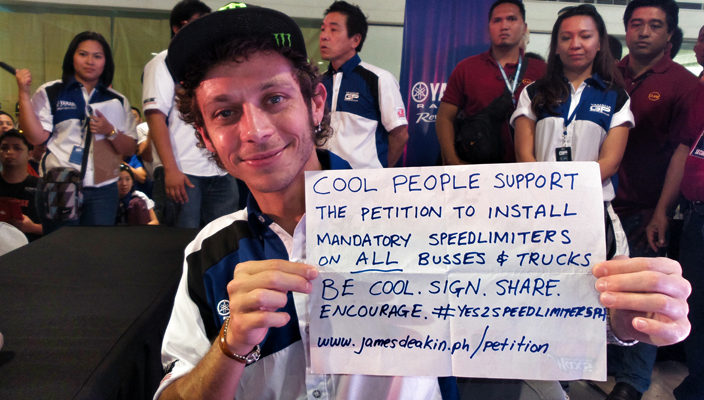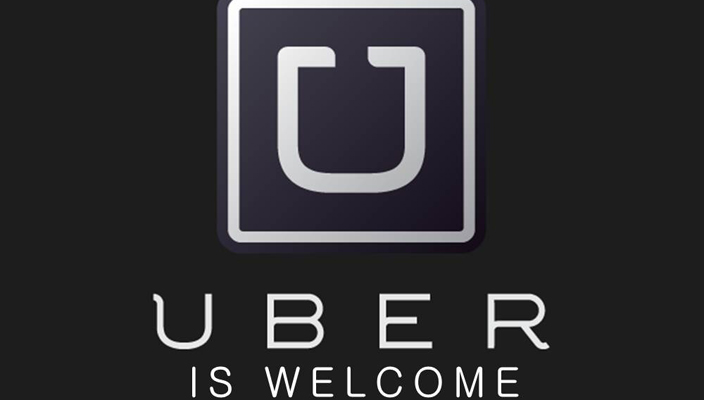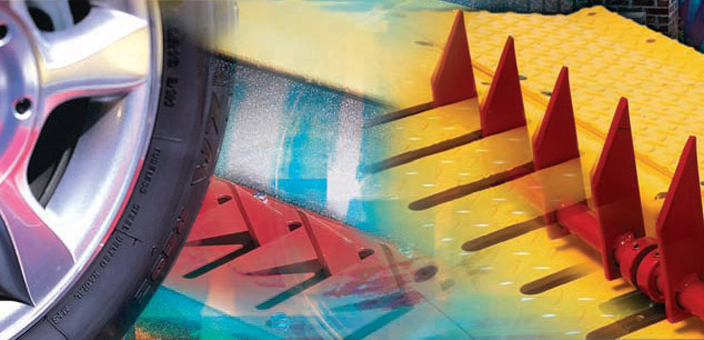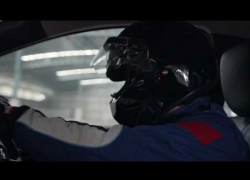1. I would swap the No Plate, No Travel policy with a No plate, No Job policy.
 Basically, instead of the ridiculous proposal by the LTO to not allow a car that has been bought, registered and paid for to not ply the roads starting November 1, I would make sure that whoever it is that is responsible for not being able to provide that number plate after 18 months would be automatically required to give up their post for someone who can––which, funnily enough, is usually a prisoner. And while we’re at it, I’d take this a step further and create a policy that makes any public suggestion of stupid policies punishable by Cedric Lee.
Basically, instead of the ridiculous proposal by the LTO to not allow a car that has been bought, registered and paid for to not ply the roads starting November 1, I would make sure that whoever it is that is responsible for not being able to provide that number plate after 18 months would be automatically required to give up their post for someone who can––which, funnily enough, is usually a prisoner. And while we’re at it, I’d take this a step further and create a policy that makes any public suggestion of stupid policies punishable by Cedric Lee.
2. Require all buses to have electronic speed limiters.
 Not the GPS ones, but mandatory active speed limiters that restricts them from going above 80 km/h. No exceptions. They would also be subject to annual checks for roadworthiness and random safety checks. Anyone caught running with bald tires or worn brakes would be charged with attempted murder; it would also be mandatory for bus companies to have the amount of people they have severely injured or killed by negligence listed down on the back and sides of each bus (This bus company has killed 10 people due to recklessness) Sort of like the signs they place outside construction sites, factories or on cigarette packets. Let’s see how they drive then.
Not the GPS ones, but mandatory active speed limiters that restricts them from going above 80 km/h. No exceptions. They would also be subject to annual checks for roadworthiness and random safety checks. Anyone caught running with bald tires or worn brakes would be charged with attempted murder; it would also be mandatory for bus companies to have the amount of people they have severely injured or killed by negligence listed down on the back and sides of each bus (This bus company has killed 10 people due to recklessness) Sort of like the signs they place outside construction sites, factories or on cigarette packets. Let’s see how they drive then.
3. Incentivize UBER and similar car hire/sharing platforms.
 The LTFRB may be well within their legal right to shut Uber down, but let’s face it, Uber and Grab car only took off because the very agency that is meant to regulate our public transport has failed us miserably. Not a week goes by when I don’t come across a horror story of either, robbery, assault, rape (or all three) from terrified passengers, and now that someone comes up with a safe alternative, what do they do? Fine them 200,000 pesos. Brilliant. It’s no different to fining someone for having a security guard for the sole reason that the government already provide police. I’m not arguing the legalities here––I’m well aware of the court cases, strikes and controversies in many other countries––but those are usually in places where the public transport system is effectively regulated. So fair enough. But that being far from the case here, why can’t the LTFRB work together with Uber to see how they could legitimize them to solve a much, much, much bigger problem? Am I the only one that finds it incredibly ironic that the same agency that allowed colorum trucks recently are now going all John McLane on Uber’s ass? So rather than penalizing, why not try incentivizing? Think about it. If we incentivized it, more and more platforms would compete and the rates would drop low enough to end up being cheaper than owning and maintaing a car, which could have dramatic effects on congestion and the environment. Theoretically, if an Uber picked up 20 passengers, that is potentially 20 less cars on the road. It is simple math––but then again, seeing how long it has taken to get a simple speed limiter rule implemented on buses, I may be aiming too high here. So for now, I would encourage the developers of the car-pooling app, Tripid, to restructure their business model where instead of charging per trip and taking a commission, they charge the users a monthly subscription to their service that connects drivers and passengers who are going the same way. Whatever both parties agree on in private to split the cost of the gas is their business, and something that has not only been going on for decades, but is actually highly encouraged.
The LTFRB may be well within their legal right to shut Uber down, but let’s face it, Uber and Grab car only took off because the very agency that is meant to regulate our public transport has failed us miserably. Not a week goes by when I don’t come across a horror story of either, robbery, assault, rape (or all three) from terrified passengers, and now that someone comes up with a safe alternative, what do they do? Fine them 200,000 pesos. Brilliant. It’s no different to fining someone for having a security guard for the sole reason that the government already provide police. I’m not arguing the legalities here––I’m well aware of the court cases, strikes and controversies in many other countries––but those are usually in places where the public transport system is effectively regulated. So fair enough. But that being far from the case here, why can’t the LTFRB work together with Uber to see how they could legitimize them to solve a much, much, much bigger problem? Am I the only one that finds it incredibly ironic that the same agency that allowed colorum trucks recently are now going all John McLane on Uber’s ass? So rather than penalizing, why not try incentivizing? Think about it. If we incentivized it, more and more platforms would compete and the rates would drop low enough to end up being cheaper than owning and maintaing a car, which could have dramatic effects on congestion and the environment. Theoretically, if an Uber picked up 20 passengers, that is potentially 20 less cars on the road. It is simple math––but then again, seeing how long it has taken to get a simple speed limiter rule implemented on buses, I may be aiming too high here. So for now, I would encourage the developers of the car-pooling app, Tripid, to restructure their business model where instead of charging per trip and taking a commission, they charge the users a monthly subscription to their service that connects drivers and passengers who are going the same way. Whatever both parties agree on in private to split the cost of the gas is their business, and something that has not only been going on for decades, but is actually highly encouraged.
4. Install counterflow spikes on all one way roads.
Because traffic enforcers will always be too scared to pull over a politician’s convoy or the jeepney driver that will take him home later, each city government should install a set of ‘one way spikes’ spaced evenly along main roads that is perfectly harmless to those traveling in the correct direction, but approach it from the opposite direction, and boom! What are a new set of 19 inch tires worth again? These have been in use in car parks around the world for decades now. Nobody has ever used them on main thoroughfares, but then again, not many people have ever had the need to. I think we have reached this stage. I’d also include them in intersections for red lights and the yellow box. Imagine a set of spikes embedded into the entire square of an intersection. The idea is, once a light goes red, the spikes are released from the ground and then retracted after about 2 seconds. If you happen to still be in the middle of the intersection, you might want to visit your local tire dealer. The best part about this is that it does double duty for those wanting to beat the red light. Two turds for the price of one.
5. Raise the prices of driver's licenses and have much, much stricter testing.
There's always radical suggestions like banning private cars from EDSA, why don't they just try banning stupidity? By raising the requirements for licenses, plus the fees, you would automatically solve more than half the problem. Driving is a privilege, not a right, and the mere fact that it is at least a 10 times harder to get a post paid phone line than it is to operate a deadly weapon speaks volumes about the reason we're in this mess to begin with. Metro Manila traffic is often referred to as a jungle. All I’m proposing here is jungle law. What stops a gazelle from entering a Lion’s den? It is certainly not an MMDA officer. And that’s the exact way we should be addressing our traffic situation.
 Basically, instead of the ridiculous proposal by the LTO to not allow a car that has been bought, registered and paid for to not ply the roads starting November 1, I would make sure that whoever it is that is responsible for not being able to provide that number plate after 18 months would be automatically required to give up their post for someone who can––which, funnily enough, is usually a prisoner. And while we’re at it, I’d take this a step further and create a policy that makes any public suggestion of stupid policies punishable by Cedric Lee.
Basically, instead of the ridiculous proposal by the LTO to not allow a car that has been bought, registered and paid for to not ply the roads starting November 1, I would make sure that whoever it is that is responsible for not being able to provide that number plate after 18 months would be automatically required to give up their post for someone who can––which, funnily enough, is usually a prisoner. And while we’re at it, I’d take this a step further and create a policy that makes any public suggestion of stupid policies punishable by Cedric Lee.2. Require all buses to have electronic speed limiters.
 Not the GPS ones, but mandatory active speed limiters that restricts them from going above 80 km/h. No exceptions. They would also be subject to annual checks for roadworthiness and random safety checks. Anyone caught running with bald tires or worn brakes would be charged with attempted murder; it would also be mandatory for bus companies to have the amount of people they have severely injured or killed by negligence listed down on the back and sides of each bus (This bus company has killed 10 people due to recklessness) Sort of like the signs they place outside construction sites, factories or on cigarette packets. Let’s see how they drive then.
Not the GPS ones, but mandatory active speed limiters that restricts them from going above 80 km/h. No exceptions. They would also be subject to annual checks for roadworthiness and random safety checks. Anyone caught running with bald tires or worn brakes would be charged with attempted murder; it would also be mandatory for bus companies to have the amount of people they have severely injured or killed by negligence listed down on the back and sides of each bus (This bus company has killed 10 people due to recklessness) Sort of like the signs they place outside construction sites, factories or on cigarette packets. Let’s see how they drive then.3. Incentivize UBER and similar car hire/sharing platforms.
 The LTFRB may be well within their legal right to shut Uber down, but let’s face it, Uber and Grab car only took off because the very agency that is meant to regulate our public transport has failed us miserably. Not a week goes by when I don’t come across a horror story of either, robbery, assault, rape (or all three) from terrified passengers, and now that someone comes up with a safe alternative, what do they do? Fine them 200,000 pesos. Brilliant. It’s no different to fining someone for having a security guard for the sole reason that the government already provide police. I’m not arguing the legalities here––I’m well aware of the court cases, strikes and controversies in many other countries––but those are usually in places where the public transport system is effectively regulated. So fair enough. But that being far from the case here, why can’t the LTFRB work together with Uber to see how they could legitimize them to solve a much, much, much bigger problem? Am I the only one that finds it incredibly ironic that the same agency that allowed colorum trucks recently are now going all John McLane on Uber’s ass? So rather than penalizing, why not try incentivizing? Think about it. If we incentivized it, more and more platforms would compete and the rates would drop low enough to end up being cheaper than owning and maintaing a car, which could have dramatic effects on congestion and the environment. Theoretically, if an Uber picked up 20 passengers, that is potentially 20 less cars on the road. It is simple math––but then again, seeing how long it has taken to get a simple speed limiter rule implemented on buses, I may be aiming too high here. So for now, I would encourage the developers of the car-pooling app, Tripid, to restructure their business model where instead of charging per trip and taking a commission, they charge the users a monthly subscription to their service that connects drivers and passengers who are going the same way. Whatever both parties agree on in private to split the cost of the gas is their business, and something that has not only been going on for decades, but is actually highly encouraged.
The LTFRB may be well within their legal right to shut Uber down, but let’s face it, Uber and Grab car only took off because the very agency that is meant to regulate our public transport has failed us miserably. Not a week goes by when I don’t come across a horror story of either, robbery, assault, rape (or all three) from terrified passengers, and now that someone comes up with a safe alternative, what do they do? Fine them 200,000 pesos. Brilliant. It’s no different to fining someone for having a security guard for the sole reason that the government already provide police. I’m not arguing the legalities here––I’m well aware of the court cases, strikes and controversies in many other countries––but those are usually in places where the public transport system is effectively regulated. So fair enough. But that being far from the case here, why can’t the LTFRB work together with Uber to see how they could legitimize them to solve a much, much, much bigger problem? Am I the only one that finds it incredibly ironic that the same agency that allowed colorum trucks recently are now going all John McLane on Uber’s ass? So rather than penalizing, why not try incentivizing? Think about it. If we incentivized it, more and more platforms would compete and the rates would drop low enough to end up being cheaper than owning and maintaing a car, which could have dramatic effects on congestion and the environment. Theoretically, if an Uber picked up 20 passengers, that is potentially 20 less cars on the road. It is simple math––but then again, seeing how long it has taken to get a simple speed limiter rule implemented on buses, I may be aiming too high here. So for now, I would encourage the developers of the car-pooling app, Tripid, to restructure their business model where instead of charging per trip and taking a commission, they charge the users a monthly subscription to their service that connects drivers and passengers who are going the same way. Whatever both parties agree on in private to split the cost of the gas is their business, and something that has not only been going on for decades, but is actually highly encouraged.4. Install counterflow spikes on all one way roads.

Because traffic enforcers will always be too scared to pull over a politician’s convoy or the jeepney driver that will take him home later, each city government should install a set of ‘one way spikes’ spaced evenly along main roads that is perfectly harmless to those traveling in the correct direction, but approach it from the opposite direction, and boom! What are a new set of 19 inch tires worth again? These have been in use in car parks around the world for decades now. Nobody has ever used them on main thoroughfares, but then again, not many people have ever had the need to. I think we have reached this stage. I’d also include them in intersections for red lights and the yellow box. Imagine a set of spikes embedded into the entire square of an intersection. The idea is, once a light goes red, the spikes are released from the ground and then retracted after about 2 seconds. If you happen to still be in the middle of the intersection, you might want to visit your local tire dealer. The best part about this is that it does double duty for those wanting to beat the red light. Two turds for the price of one.
5. Raise the prices of driver's licenses and have much, much stricter testing.
There's always radical suggestions like banning private cars from EDSA, why don't they just try banning stupidity? By raising the requirements for licenses, plus the fees, you would automatically solve more than half the problem. Driving is a privilege, not a right, and the mere fact that it is at least a 10 times harder to get a post paid phone line than it is to operate a deadly weapon speaks volumes about the reason we're in this mess to begin with. Metro Manila traffic is often referred to as a jungle. All I’m proposing here is jungle law. What stops a gazelle from entering a Lion’s den? It is certainly not an MMDA officer. And that’s the exact way we should be addressing our traffic situation.



